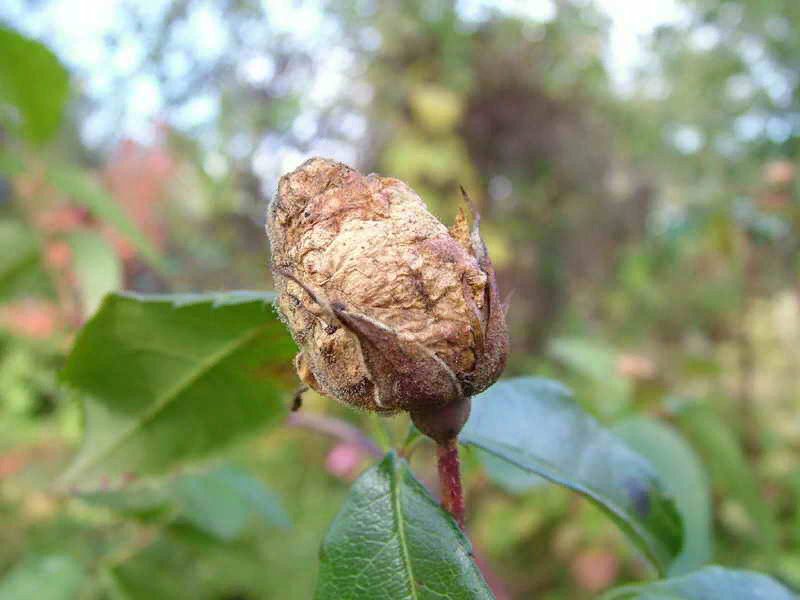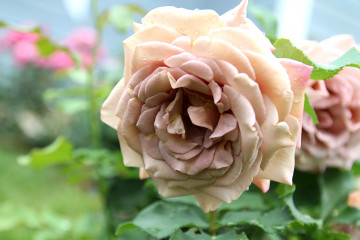Rose Emilien Guillot - description of varietal shrub
Content:
This article will discuss the Emilien Guillot rose, its description and all the intricacies of its cultivation. After reading it, you can get the opportunity to properly grow this bush and in the future contemplate the most beautiful of roses on your own plot.
Description of the rose
Emilien Guillot is a special kind of rose that differs from others in that its magnificent, starting from salmon-orange, smoothly transitioning to orange-red, the appearance stands out very brightly against the background of the foliage. The red-orange bud has a rounded shape. The flowers are cupped, reaching about 12 cm, with an average diameter of 11-12 cm. The bush itself is about 80-100 cm high and 60-70 cm wide.
Rose Emilien Guillot - the reigning representative of the species of spray roses, which has luxurious delicate buds. Emilien Guillot is a darling of landscape designers. It is this variety that has the following advantages: immunity to most diseases inherent in other species, flowering throughout the season, the beauty of huge scarlet or bright orange buds, a delightful smell, especially in the morning and evening hours.
History of creation and names
The rose is dedicated to one of the heirs of the Guillot dynasty. The first flower appeared in public in 1997. The Emilien Guillot variety is considered special, because the work on its uniqueness has been carried out for many years. Having discovered the amazing result that was achieved, the breeder named the rose after his son.
How to grow beautiful spray roses
Planting is carried out in the form of seedlings of 4-5 shoots with a developed root system. Flowers are grown between April-May or August-September. Rosa Emilien Guillot, like any other, loves good lighting, moisture, air and warmth.
She will delight for a long time with her lush flowers, especially in landscape design, from which you can then collect a large bouquet. A great spot for this plant is the one that slopes southward. Sunlight at the beginning of planting is especially important, because the abundant evaporation of moisture from the surface of the leaves greatly reduces the risk of infection with fungal diseases and others that are harmful to the health of the plant.
Location selection
The soil should not be sandy, you need to choose a site with a predominance of loamy soil. If the planting of seedlings is scheduled for the spring, then the holes for them should be prepared in the autumn. When planting a rose as soon as possible, you need to prepare a hole at least 2-3 weeks in advance.
The seedling is cut so that about 4-5 shoots remain on it, where there are three buds. Before planting, the roots are usually kept in a special solution consisting of diluted manure and clay in water, which creates a nutrient medium for seedlings for the first time. So Emilien Guyot will take root much better and faster.
Rose care
First, you need to water it in small portions and water it regularly every day for a week. If the seedling is not rooted, you can continue to water abundantly for another week and add compost for moisture.
The formation of the bush must be done in the first year. After the appearance of the fifth leaf, the shoot must be pinched. For Emilien Guyot, high growth is important, therefore, the vertical shoots do not need to be touched, the lateral ones must be pinched, and to give the bush a larger volume, the inner ones must also be cut off.
The most important thing for the Emilien Guillot rose to show itself in all its fragrance and grace is moisture and soil rich in nutrients.
Blooming rose
The first flowering occurs at the end of May. Dense double flowers begin to cover the bush. The buds are sometimes collected in inflorescences. In the warmest periods, the flower requires a temperature of 24 ° C, during the dormant period (from October to February) it is lowered to 6-7 ° C.
Care during and after flowering
During the flowering period of the Emilien Guillot rose, it is necessary to water it in the morning or evening with warm, settled water. During watering, you need to moisten the mulch at the roots or soil, and not the plant itself. In addition, it is necessary to create ventilation for the bush, prevent it from thickening, carry out sanitary pruning in time and not plant large plants nearby, which will block the air flow to the leaves and stem.
The variety is frost-resistant. Despite this, the shrub needs shelter for the winter and some preparation for the cold season: you need to pinch the top at the end of September.
There is no need to dig up the soil surrounding the bush before the cold snap. From mid-September until the arrival of spring, you do not need to water the plant. Before the cold snap, the bush is covered with sand. A small hill is made of it, about 40 cm high.
What can be done if it does not bloom
If roses do not bloom, then you need to remember the time planted. If more than three years have passed since her moment, you need to start rejuvenation. It is easy to identify old plants: the stems become woody, lose their green color, becoming covered with thick bark.
The reason why a rose does not bloom on the site may be a shortage or excess of fertilizers applied to the soil. The main sign of an overabundance of nitrogen fertilizing is the active growth of lush foliage upward without the formation of buds. The situation can be corrected by applying phosphorus-potassium fertilizer or ash.
Improper rose maintenance is another reason for the lack of flowers. It is necessary to prune the rose annually. Without this, flowering will gradually decline. But summer residents do not always carry out the procedure correctly. Most often, roses suffer from strong pruning, which disrupts metabolic processes and weakens the plant. Therefore, it is worth limiting ourselves to sanitary pruning, removing diseased and damaged shoots, as well as forming, which will give the bush a decorative look.
A rose, "suffocated" by root shoots, will not bloom either. Rosehip shoots, on which cultivars are most often grafted, do not bloom. Novice gardeners often consider it to be a varietal rose. The overgrowth must certainly be destroyed, since it steals the nutrients from the rose and strangles it completely.
Flower propagation
Rose Emilien Guillot begins to bear fruit from mid-July. They contain oval-shaped seeds of light brown color. To grow a rose Emilien from seed, you need:
- Remove the fruit a little unripe, when the skin of the seeds has not yet become coarse. This seed grows well. Using a sharp knife, cut the fruit and take out the seeds, freeing them from the pulp.
- You need to take two cotton pads, soak them well with hydrogen peroxide. Put the seeds on one, and cover them with the second.
- The seeds are wrapped in a damp cloth and placed in a plastic bag. All this is placed in a cool place (it is better that the temperature is about 5 ° C). It is necessary to constantly check the package and maintain the moisture of the fabric. In this state, the seeds are stored for two months.
- Next, you need to mix the soil with peat and spread out in pots. Transplant the prepared seeds into them and wait until they germinate. After that, transplant the flower into open ground.
Also, the rose is propagated by layering. This is the easiest way to propagate roses. This method is used if you want minimal damage to the parent bush. The lower branch is bent to the ground and covered with soil, leaving only the top. Where the shoot is sprinkled, roots are formed. Layers are usually laid in early spring. To ensure success, shoots with a developed root-forming ability are used, which are located shallow underground.
Pests and diseases
The main pests are: rose aphid, rose leafhopper, thrips. Also, the rose is harmed by different types of sawflies, beetles, bronze, weevils. To combat these parasites, pesticides are most often used.
Rose Emilien Guillot will hurt if it grows in the wrong place for her. Gray rot, for example, spreads especially briskly in rainy weather. In addition, most gardeners plant roses densely, the soil under the plants dries too slowly after rain. You can fight gray rot in the initial stages by cutting out the affected areas and creating a dry warm climate for the rose.
All these efforts, the tests that will need to be passed, will be worth it for such an amazing rose to grow in the garden. She will brighten up any gloomy day with her dazzling beauty.



















